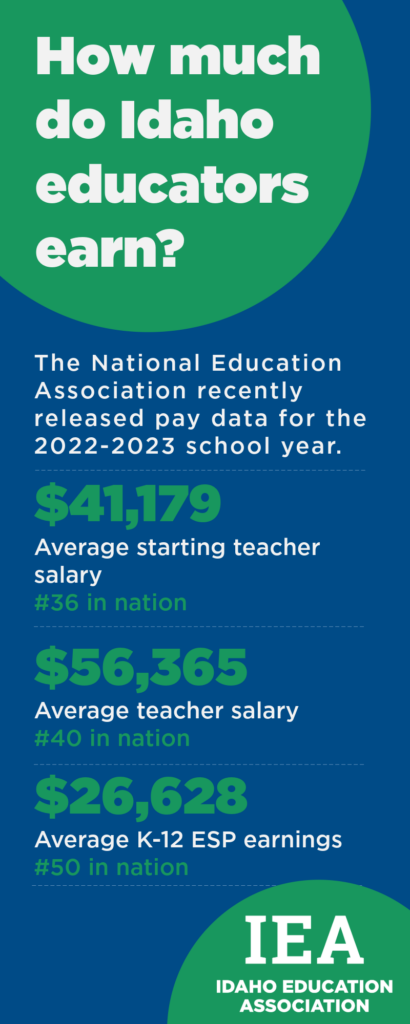The National Education Association’s annual report on educator salaries reveals Idaho lags well behind the national average in starting educator salaries and K-12 education support professional salaries. However, the state jumped two places in the national rankings for average teacher salary, from #42 to #40.
 The data is based on the 2022-2023 school year. The report does not reflect educator pay raises secured during the 2023 session of the Idaho Legislature and spearheaded by Governor Brad Little.
The data is based on the 2022-2023 school year. The report does not reflect educator pay raises secured during the 2023 session of the Idaho Legislature and spearheaded by Governor Brad Little.
“Although these numbers do not completely reflect recent investments made in educator pay in Idaho, they do highlight that Idaho educators have endured salaries that are far too low, even as demands on them continue to grow,” says Idaho Education Association President Layne McInelly. “This year’s report is yet another example of how decades of chronic underfunding by the State of Idaho shortchanges the backbone of our education system: the hardworking educators who dedicate their careers to our state’s children.”
LEARN ABOUT IDAHO’S CHRONIC UNDERFUNDING OF PUBLIC EDUCATION
As the report points out, even seemingly rosy numbers are clouded by persistent inflation. The average starting teacher salary increased 3.4 percent — but when adjusted for inflation, teachers are earning 5 percent less than they did just a decade ago.
Idaho’s education support professionals are even more underpaid than their certified educator colleagues. The state’s average ESP salary of $26,628 ranks 50th nationwide — dead last and well below the federal poverty threshold for a family of four.
In comparison, the average salary for Idahoans across all industries is $51,350. According to a recent analysis, a single person in Idaho must earn $88,783 to live comfortably (including food and housing, wants, and savings).
While a portion of the state’s investment in educator salaries in 2023 was earmarked for ESP wages, the bulk of the funding went to raise the pay of certified educators.
“ESPs and classified school district employees are the backbone of every public school in the state,” said Chris Parri, IEA’s political director. “They work as paraprofessionals, administrative assistants, custodians, bus drivers, security and technology staff, food service workers and other roles vital to student and school success. They deserve a living wage.”
Nationwide, 38 percent of full-time K-12 ESPs earn less than $25,000 per year, while 12.5 percent earn less than $15,000.
“The data clearly highlights the disparity between state allocations and the reality districts face trying to hire and retain quality educators,” Parri said.
READ THE FULL NEA SALARY REPORT
The NEA report also showcased how unions make a demonstrable difference in the salaries of educators. In states with collective bargaining, which includes Idaho, teachers earn 26 percent more on average, while staff earn 16 percent more.
“Our union has worked with Governor Little to pass massive investments in public education, including teacher pay,” McInelly says. “We will use our collective voice, both in the Legislature and at the ballot box, to continue to move the needle. As the NEA report highlights, unions have the power to create significant change in the working lives of our educators.”